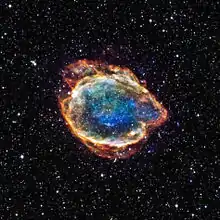Barnard's Loop
Barnard's Loop (catalogue designation Sh 2-276) is an emission nebula in the constellation of Orion. It is part of the Orion molecular cloud complex which also contains the dark Horsehead and bright Orion nebulae. The loop takes the form of a large arc centered approximately on the Orion Nebula. The stars within the Orion Nebula are believed to be responsible for ionizing the loop.
| Emission nebula | |
|---|---|
| H II region | |
 Barnard's Loop can be seen on this image as a diffuse red semicircle. | |
| Observation data: J2000 epoch | |
| Right ascension | 05h 27.5m |
| Declination | −03° 58′ |
| Distance | either 518 or 1434 ly |
| Apparent magnitude (V) | 5 |
| Apparent dimensions (V) | 10° |
| Constellation | Orion |
| Physical characteristics | |
| Radius | either 50 or 150 ly |
| Designations | Sh 2-276 |
The loop extends over about 600 arcminutes as seen from Earth, covering much of Orion. It is well seen in long-exposure photographs, although observers under very dark skies may be able to see it with the naked eye.
Recent estimates place it at a distance of either 159 pc (518 light years)[1] or 440 pc (1434 ly)[2] giving it dimensions of either about 100 or 300 ly across respectively. It is thought to have originated in a supernova explosion about 2 million years ago, which may have also created several known runaway stars, including AE Aurigae, Mu Columbae and 53 Arietis, which are believed to have been part of a multiple star system in which one component exploded as a supernova.[3]
Although this faint nebula was certainly observed by earlier astronomers, it is named after the pioneering astrophotographer E. E. Barnard who photographed it and published a description in 1894.[4]
 Above photo of Barnard's Loop nebula in inverted black and white of the red channel
Above photo of Barnard's Loop nebula in inverted black and white of the red channel Long exposure of Orion with red clouds of ionized hydrogen (H-alpha). The big bow on the left is Barnard's Loop.
Long exposure of Orion with red clouds of ionized hydrogen (H-alpha). The big bow on the left is Barnard's Loop. Barnard's Loop seen against the major stars and nebula of Orion
Barnard's Loop seen against the major stars and nebula of Orion
References
- Wilson, B.A.; Dame, T.M.; Masheder, M.R.W.; Thaddeus, P. (2005). "A uniform CO survey of the molecular clouds in Orion and Monoceros". Astronomy and Astrophysics. 430 (2): 523–539. arXiv:astro-ph/0411089v1. Bibcode:2005A&A...430..523W. doi:10.1051/0004-6361:20035943. S2CID 13916583.
- O'Dell, C.R.; Ferland, G.J.; Porter, R.L.; van Hoof, P.A.M. (2011). "Physical Conditions in Barnard's Loop, Components of the Orion-eridanus Bubble, and Implications for the Warm Ionized Medium Component of the Interstellar Medium". The Astrophysical Journal. 733 (1): 9. arXiv:1103.2789. Bibcode:2011ApJ...733....9O. doi:10.1088/0004-637X/733/1/9. S2CID 5019523.
- "The Internet Encyclopedia of Science: Barnard's Loop (Sh 2-276)". David Darling. Archived from the original on 12 March 2008. Retrieved 2008-04-22.
- Barnard, E. E. (1894). "The great photographic nebula of Orion, encircling the belt and theta nebula". Popular Astronomy. 2: 151–154. Bibcode:1894PA......2..151B. doi:10.1086/102137.
- Gaylard, M. J. (1984), "Detection of the H 142-alpha line from the Barnard Loop", Monthly Notices of the Royal Astronomical Society, 211: 149–153, doi:10.1093/mnras/211.1.149
- Reynolds, R. J.; Ogden, P. M. (1979), "Optical evidence for a very large, expanding shell associated with the I Orion OB association, Barnard's loop, and the high galactic latitude H-alpha filaments in Eridanus", Astrophysical Journal, 229: 942–953, Bibcode:1979ApJ...229..942R, doi:10.1086/157028

